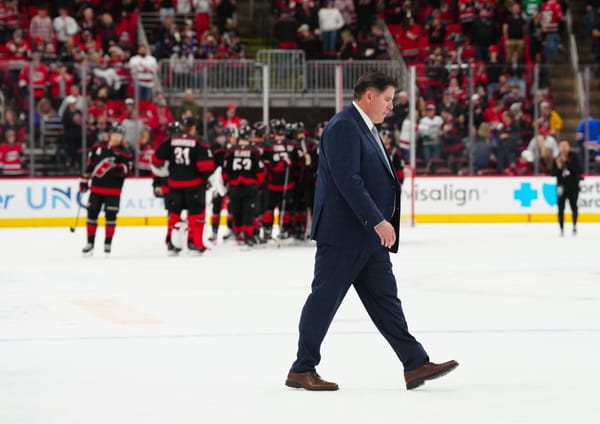2022 Report Card: Ryan Strome
The now-former Ranger was very good but often frustrating at the same time.
Expectations
On Nov. 16, 2018, the New York Rangers acquired Ryan Strome from the Edmonton Oilers, in exchange for Ryan Spooner. It was a savvy buy-low move of a struggling player who had previosuly been selected fifth overall by the New York Islanders in the 2011 NHL Draft. Indeed, the trade turned out to be one of then-GM Jeff Gorton’s best for the organization, as Strome solidified his role as a second-line center with the Blueshirts, while Spooner appeared in only 36 NHL games (totaling seven points) after the trade, and none since the 2018-19 season.
Spooner had been part of the Rangers’ return for dealing Rick Nash to the Boston Bruins earlier in 2018, along with Ryan Lindgren, Matt Beleskey, and a first-round draft pick for that summer that the Rangers eventually packaged as part of a trade-up move to select K’Andre Miller. Turning Spooner into Strome, on top of getting blue-line fixtures in Lindgren and Miller out of the deal, represents quite a haul for the Rangers.
With Strome posting some strong scoring totals over his first two-plus seasons with the Rangers, the expectation was that he would continue to serve as a very good number-two center, and hopefully build upon his impressive 2020-21 season where he totaled 49 points in 56 games.
Strome, while effective overall, nevertheless had his flaws that drew the ire of the fan base. As he was set to hit free agency at the end of this past season, the overwhelming feeling among fans (or at least the pulse I got via Rangers Twitter — i.e., the most reliable source there is) was that he was a good player but that it was time for both parties to move on. That’s exactly what happened, as Strome signed a five-year deal with the Anaheim Ducks shortly after the Rangers replaced him by signing Vincent Trocheck.
Let’s dive into some specifics of Strome’s performance from the 2021-22 season.
Performance
Strome established a new career high with 21 goals during the 2021-22 season, to go along with 33 assists for a total of 54 points in 74 games. He was part of the Rangers’ lethal top power-play unit, though was more of an unsung player that helped make the unit click while not piling up as many points as others. Strome tallied 14 of his 54 points on the power play; his 39 even-strength points were tied with Chris Kreider and Adam Fox for the third-most on the team.
While hitting the 50-point threshold for the third time in his career was impressive, and in line with the level of raw production needed from a second-line center, Strome was not quite able to reach the scoring pace he achieved in the COVID-truncated 2020-21 season. In the two seasons prior to that, Strome scored a career-high 59 points (on the strength of 41 assists) in 2019-20, and 33 points in 63 games after joining the Rangers a short way into the 2018-19 season.
Strome developed a close bond with Artemiy Panarin, which aligned with the obvious chemistry the two shared on the ice. Though the Rangers sometimes shuffled their lines, Strome became firmly entrenched as the second-line center, usually with Panarin on his left side.
As such, it’s easy to say that playing alongside a prolific point producer like Panarin helped Strome inflate his own scoring totals. However, while that might be true to some extent, it would be selling Strome’s accomplishments short. For instance, in 2020-21, Panarin missed 14 games, but Strome managed to maintain the best points-per-game rate of his career for the whole season. In addition, per Natural Stat Trick, Strome helped the Rangers to a better five-on-five expected goals share without Panarin on the ice alongside him (53.17 percent) than when they were on the ice together (49.27 percent).
To that end, Strome’s player card for the following season, via Evolving Hockey, paints a supporting picture of a player who was excellent at generating offense, which made his below-average (though not abjectly horrible) defense acceptable.
Off the ice, Strome seemed to be well-liked in the locker room and respected; he was also one of the Rangers’ infamously high total of six alternate captains. During interviews with the media, Strome typically provided more than just vanilla hockey-player quotes, and was thoughtful and thorough in his answers. Personally, I think he would do well in a studio analyst or color commentator role once his playing days are behind him.
Despite his good overall play, the laudable way in which he re-established his career after being traded to the Rangers, and the value he provided as one of the leaders on a very young team, something about Strome created some polarization, and always left a number of fans wanting more.
Venerable Rangers Twitter user @FitzGSN_ put it pretty eloquently:
I’ve said the entire time: he simultaneously exceeded every single expectation I ever had of him and was still exactly who I always thought he was
— Fitz (@FitzGSN_) July 14, 2022
When using words like “maddening” and “frustrating” to describe Strome, the first thing that comes to mind is his meme-worthy inability to score on open nets. While usually funny and perhaps overblown initially, it ended up becoming a major problem and a big reason why the Rangers were unable to defeat the Tampa Bay Lightning in the Eastern Conference Final. Of course, it’s not fair to pin a team’s series loss entirely on one player or moment, but if Strome had finished on the slam-dunk chance he had late in Game 5 with the game tied and the series tied 2-2, the Rangers might very well have advanced to the Stanley Cup Final, where they would have been steamrolled anyway by the Colorado Avalanche.
Panarin to Copp to Strome who has quiiiite a bit of space there... pic.twitter.com/aYuKxCAQu2
— Shayna (@hayyyshayyy) June 10, 2022
In the following game, which proved to be the final contest of the Rangers’ season, Strome was clearly hobbling as he was nursing a pelvis injury, and he should not have played. But head coach Gerard Gallant dressed him anyway. While it was courageous of Strome to do everything he could to be out there and try to help his team, his compromised state ultimately hurt the Rangers more than it helped. He ended up exiting the game in the second period, leaving New York shorthanded for the rest of the night. What made it worse was that Gallant had already inexplicably scratched Kaapo Kakko, so the Rangers’ already-struggling offense lacked the requisite depth to fight back and win the game.
Throughout the year, Strome also had a tendency to take untimely, back-breaking penalties, many times in the offensive zone. In the regular season, his 27 minor penalties were the second-most on the team, behind only defenseman Jacob Trouba’s 29.
Author Grade: B
Banter Consensus: B-
After the Rangers landed Strome from Edmonton, he provided the Rangers with what was probably a best-case scenario in terms of production. While he had reached 50 points one time before (in his second season with the New York Islanders in 2014-15), he struggled thereafter with scoring totals in the low-to-mid 30s, and then just two points in 18 games in 2018-19 before the trade. So, Strome playing the best hockey of his career with the Rangers was a clear win, and he remained a solid contributor on the 2021-22 squad while continuing to grow as a respected leader on the team.
With all those good attributes, however, came some negatives in the form of glaring blown chances, untimely penalties, and countless head-scratching and frustrating moments. Net-net, Strome was a good player for the Rangers, but a refresh via the seemingly more well-rounded Vincent Trocheck might ultimately be more beneficial for the club. In the meantime, Strome gets to rake in $25 million over five years in southern California, so both parties appear to be in a good spot post-divorce.
Note: Stats obtained via Hockey Reference, Natural Stat Trick, Evolving Hockey, and NHL.com.





